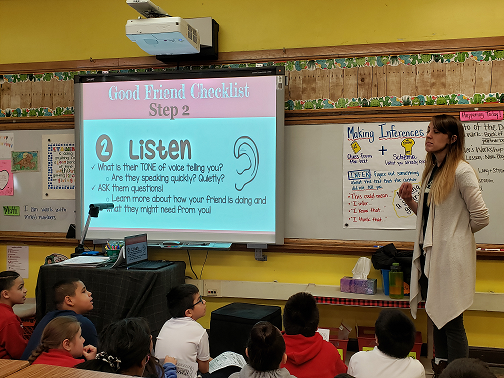Empathy education. Is it valuable? Should teachers set aside precious time and resources to have students learn to appreciate one another? What about teachers in schools where the performance is not high? Can they afford to focus on social-emotional learning? I got my answer last week when I visited a public elementary school on Chicago’s southwest side. I saw rigorous, top-tier teaching that centered around building empathy and enacted best-practices that will likely raise student test scores in the near term and give them life-supporting skills for the long term.
Hale Elementary School hosts 928 students, 73% of whom are Hispanic and 71% of whom receive free and reduced lunch. They rank in the 54th percentile for overall student performance in the state of Illinois. Their average test score is 50%. One prominent website ranks the school as number 976 of 2,100 schools in the state of Illinois. Hale recently took a big step in adopting an empathy curriculum, The Nora Project, and from what I saw last week they made a great choice for these students. Why? Because I saw great, standards-based teaching that employed literacy and critical thinking strategies proven to raise student performance.

I first walked into a computer lab where the 5th grade Nora Project lesson involved students creating documentary videos about their peers. Students worked in pairs, interviewing one-another to learn more about their hobbies, family members, early memories, and goals in life. They each seamlessly logged into their own pre-formatted Google Doc to capture their notes as part of their pre-filming research. I discovered that the lab teacher, Ms. Doyle, was also a parent of a child with disabilities. She was a primary advocate for bringing the project to the school and was motivated to deliver an ELA / SEL (English language arts / social-emotional learning) lesson like this even though it fell outside of the typical computer lab experience.
The second class I visited provided a fine example of best-practice teaching. Ms. Spenser was leading a lesson about friendship where the ultimate objective was to have her 3rd graders write journals about how they could display acts of friendship given a difficult situation. Could third graders in this mid-performing school possibly accomplish this task? The answer was an emphatic YES, and the teaching practices Ms. Spencer employed within a crisp, 30-minute lesson made it all work. Here are some specific strategies she employed. If you are reading this as a non-academic, then . . . trust me, these are teaching behaviors supported by the leading research to promote great student outcomes:
- Student-to-student productive discourse in a warm-up lesson that included carefully scripted partnering techniques, building background knowledge, and having each student find their own voice
- Continuing on-task verbal engagement throughout the lesson that included turn-and-talk, choral recitation of an academic term, wait time, re-voicing, and adding on
- Creating an anticipatory set before showing a video so that the students had a clear objective in watching together and were able to analyze the video thoughtfully
- Journaling, with an initial sentence stem provided by the teacher, so that students could make their thinking visible
The journaling task at the end of the lesson was glorious! Third graders. Each of them immediately moving their pencils. Total focus and confidence on the part of every student I observed. Amazing at any school, especially remarkable with this population.

The Nora Project is designed to teach empathy and spark friendships between students and their peers with disabilities. It was started by a Chicago-area mom whose daughter, Nora, has significant disabilities. The project has employed excellent curriculum developers who have designed rigorous, standards-based lessons and taken the content beyond the disabilities focus. The curriculum spans grades TK–12, generally occupies 30 minutes per week in the elementary years, and supports ELA, NGSS (science), and SEL standards. I serve on their Leadership Council and this was my first opportunity to see the project in action. We took a risk to visit a school where the project leaders have little experience. The risk paid off!
I give credit where credit is deserved. The students I saw came to school ready to learn and they delivered for themselves, one another, and their teachers. Ms. Spencer is clearly a teacher who is dedicated to her craft. Watching her teach was the highlight of my day. Ms. Doyle exercised the professional initiative to bring this project to her campus. The school administration is clearly supporting this effort, as evidenced by a large percentage of students and staff donning their Nora Project t-shirts on the day of our visit. And the Nora Project team – they are demystifying disability, normalizing differences between students, and remediating bullying while they help students to build empathy and friendships.